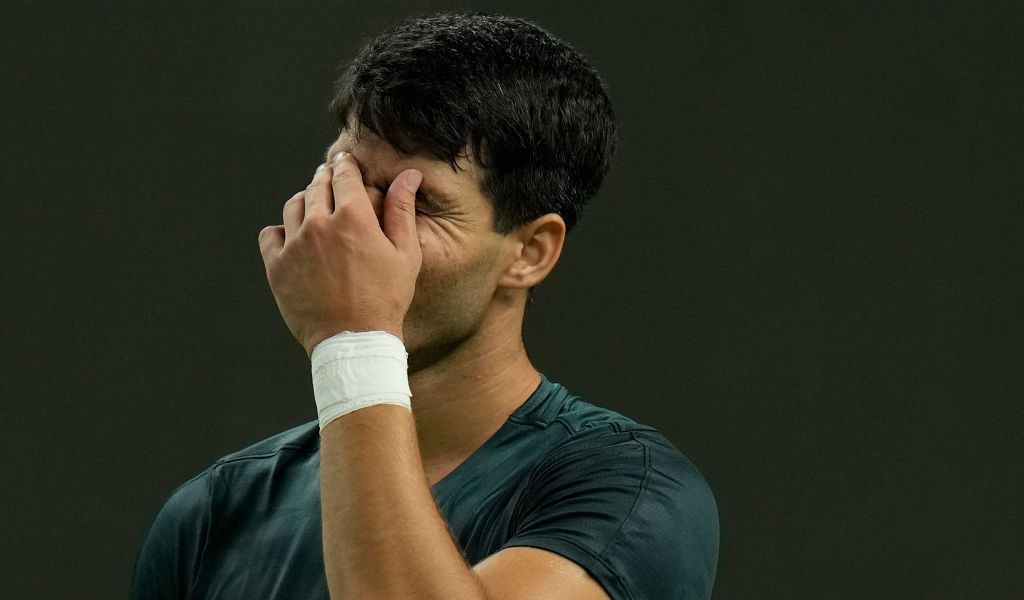<!–
–>

Novak Djokovic is the undisputed world No 1 after a dominant year that saw him win three Grand Slam titles, but his nearest rival in the rankings may be on the slide.
Carlos Alcaraz has been Djokovic’s chief rival over the course of 2023, with the pair playing out three epic matches that suggested they are ready to push each other to new heights.
Djokovic prevailed in a titanic battle at the French Open, as cramps affected his young rival in a semi-final that was gripping over the opening two sets.
Alcaraz then pulled off a stunning victory over Djokovic in the Wimbledon final, ending the Serbian’s enduring reign as the king of the Centre Court at the All England Club.
The duo then played out what was arguably the match of the year at the Cincinnati Masters, with their epic contest in the final won by Djokovic after he was pushed all the way by his youthful rival.
All the pointers suggested we would see a Djokovic vs Alcaraz US Open final a few weeks later, but that match-up failed to materialise after Alcaraz lost to Daniil Medvedev in the semi-finals.
Since that defeat, the 20-year-old has struggled to find his best form, with defeats against Jannik Sinner and Grigor Dimitrov in China backed up by a shock loss against world No 45 Roman Safiullin at the Paris Masters.
Now the latest UTR ratings have been released and they suggest Alcaraz is not the second best or even the third best player in the world.
Medvedev has jumped to second place in the UTR rankings after his impressively consistent form in 2023, including five titles on the ATP Tour.
Sinner is up to third in the UTR list after an impressive run of form including a victory against Alcaraz en route to lifting the China Open title, his fourth ATP Tour win of the year.
Alcaraz is next on the UTR list in fourth place, with Germany’s Alexander Zverev up to fifth after his impressive return to form in 2023 saw him qualify for the end-of-year ATP Finals.
Bulgaria’s Grigor Dimitrov will not be at the ATP Finals in Turin, but he is up to No 7 in the latest UTR rankings after a stunning burst of form including his run to the final of the ATP Masters 1000 event in Paris.
Australia’s Alex De Minaur is also in the UTR top ten after his impressive form over the last year.
Our November rankings have arrived… 👀📊
Any surprises in our latest men’s Top 10? pic.twitter.com/dminNGndqW
— UTR Sports (@UTR_Sports_) November 2, 2023
While the ATP Rankings remain the official gauge of the state of play in the men’s game, the UTR rating use a different algorithm to compile their list.
“The UTR Rating is the world’s most accurate rating system. All players regardless of age, gender, geography or skill level, are rated on the same scale from 1.00 and 16.50 based on daily match results,” reads the description on the URT website of how the rating is generated.
“UTR Rating is a number that provides a real and accurate measurement of skill level. A player’s UTR is a number between 1.00 and 16.50.
“One match result is all it takes to receive a projected UTR Rating. After approximately five matches, the rating becomes fully reliable. As matches are played and entered into the system, a player’s UTR will increase or decrease over time as per the following methodology.
“For each match, the algorithm calculates a match rating and a match weight for each player. A player’s UTR Rating is the weighted average of up to 30 of their most recent match ratings. Only matches within the last 12 months count toward a player’s UTR.
“Two factors are considered when calculating the match rating. The first factor is the UTR Rating difference between opponents. The second factor is the competitiveness of the match, as determined by the percent of total games won.
“Given the UTR Rating difference, the algorithm expects a certain per cent of total games won. The player who performs better than the algorithm’s expectation will see their match rating go up while the other player’s match rating will go down. When one player’s match rating increases, the other player’s match rating decreases by the same amount.
The following factors are used in the match weight calculation:
Format – As the match format increases in length, more weight is given. A match with a three-set format receives more weight than a match with an eight-game pro set format.
Competitiveness – As the UTR Rating difference between players increases, less weight is given. For example, imagine a player with a UTR of 6.00. A match played against an opponent with a UTR Rating of 5.00 or 7.00 receives more weight than a match played against an opponent with a UTR of 4.00 or 8.00.
Reliability – As the reliability of the opponent’s UTR Rating increases, more weight is given. A match played against an opponent who competes often and thus has a reliable UTR Rating receives more weight.
Time Degradation – As prior matches get older, less weight is given. Since the algorithm is a representation of the current form, it gives more credit to matches played within the last few months.
Our November rankings have arrived… 👀📊
Any surprises in our latest men’s Top 10? pic.twitter.com/dminNGndqW
— UTR Sports (@UTR_Sports_) November 2, 2023
<!–
–>
